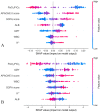To Establish an Early Prediction Model for Acute Respiratory Distress Syndrome in Severe Acute Pancreatitis Using Machine Learning Algorithm
- PMID: 36902504
- PMCID: PMC10002486
- DOI: 10.3390/jcm12051718
To Establish an Early Prediction Model for Acute Respiratory Distress Syndrome in Severe Acute Pancreatitis Using Machine Learning Algorithm
Abstract
Objective: To develop binary and quaternary classification prediction models in patients with severe acute pancreatitis (SAP) using machine learning methods, so that doctors can evaluate the risk of patients with acute respiratory distress syndrome (ARDS) and severe ARDS at an early stage.
Methods: A retrospective study was conducted on SAP patients hospitalized in our hospital from August 2017 to August 2022. Logical Regression (LR), Random Forest (RF), Support Vector Machine (SVM), Decision Tree (DT), and eXtreme Gradient Boosting (XGB) were used to build the binary classification prediction model of ARDS. Shapley Additive explanations (SHAP) values were used to interpret the machine learning model, and the model was optimized according to the interpretability results of SHAP values. Combined with the optimized characteristic variables, four-class classification models, including RF, SVM, DT, XGB, and Artificial Neural Network (ANN), were constructed to predict mild, moderate, and severe ARDS, and the prediction effects of each model were compared.
Results: The XGB model showed the best effect (AUC = 0.84) in the prediction of binary classification (ARDS or non-ARDS). According to SHAP values, the prediction model of ARDS severity was constructed with four characteristic variables (PaO2/FiO2, APACHE II, SOFA, AMY). Among them, the overall prediction accuracy of ANN is 86%, which is the best.
Conclusions: Machine learning has a good effect in predicting the occurrence and severity of ARDS in SAP patients. It can also provide a valuable tool for doctors to make clinical decisions.
Keywords: acute respiratory distress syndrome; acute severe pancreatitis; artificial neural network; machine learning.
Conflict of interest statement
The authors declare there is no conflict of interest regarding the publication of this paper.
Figures




Similar articles
-
Artificial intelligence-aided diagnosis model for acute respiratory distress syndrome combining clinical data and chest radiographs.Digit Health. 2022 Aug 15;8:20552076221120317. doi: 10.1177/20552076221120317. eCollection 2022 Jan-Dec. Digit Health. 2022. PMID: 35990108 Free PMC article.
-
[Application of machine learning model based on XGBoost algorithm in early prediction of patients with acute severe pancreatitis].Zhonghua Wei Zhong Bing Ji Jiu Yi Xue. 2023 Apr;35(4):421-426. doi: 10.3760/cma.j.cn121430-20221019-00930. Zhonghua Wei Zhong Bing Ji Jiu Yi Xue. 2023. PMID: 37308200 Chinese.
-
Machine learning for the early prediction of acute respiratory distress syndrome (ARDS) in patients with sepsis in the ICU based on clinical data.Heliyon. 2024 Mar 13;10(6):e28143. doi: 10.1016/j.heliyon.2024.e28143. eCollection 2024 Mar 30. Heliyon. 2024. PMID: 38533071 Free PMC article.
-
AI and Machine Learning for Precision Medicine in Acute Pancreatitis: A Narrative Review.Medicina (Kaunas). 2025 Mar 29;61(4):629. doi: 10.3390/medicina61040629. Medicina (Kaunas). 2025. PMID: 40282920 Free PMC article. Review.
-
Diagnosing autism severity associated with physical fitness and gray matter volume in children with autism spectrum disorder: Explainable machine learning method.Complement Ther Clin Pract. 2024 Feb;54:101825. doi: 10.1016/j.ctcp.2023.101825. Epub 2023 Dec 30. Complement Ther Clin Pract. 2024. PMID: 38169278 Review.
Cited by
-
Predictive Modeling of Acute Respiratory Distress Syndrome Using Machine Learning: Systematic Review and Meta-Analysis.J Med Internet Res. 2025 May 13;27:e66615. doi: 10.2196/66615. J Med Internet Res. 2025. PMID: 40359510 Free PMC article.
-
Tree-based ensemble machine learning models in the prediction of acute respiratory distress syndrome following cardiac surgery: a multicenter cohort study.J Transl Med. 2024 Aug 15;22(1):772. doi: 10.1186/s12967-024-05395-1. J Transl Med. 2024. PMID: 39148090 Free PMC article.
-
A systematic review of machine learning-based prognostic models for acute pancreatitis: Towards improving methods and reporting quality.PLoS Med. 2025 Feb 24;22(2):e1004432. doi: 10.1371/journal.pmed.1004432. eCollection 2025 Feb. PLoS Med. 2025. PMID: 39992936 Free PMC article.
-
Acute respiratory distress syndrome (ARDS): from mechanistic insights to therapeutic strategies.MedComm (2020). 2025 Jan 26;6(2):e70074. doi: 10.1002/mco2.70074. eCollection 2025 Feb. MedComm (2020). 2025. PMID: 39866839 Free PMC article. Review.
-
Accuracy of artificial intelligence algorithms in predicting acute respiratory distress syndrome: a systematic review and meta-analysis.BMC Med Inform Decis Mak. 2025 Jan 28;25(1):44. doi: 10.1186/s12911-025-02869-0. BMC Med Inform Decis Mak. 2025. PMID: 39875868 Free PMC article.
References
-
- Matta B., Gougol A., Gao X., Reddy N., Talukdar R., Kochhar R., Goenka M.K., Gulla A., Gonzalez J.A., Singh V.K., et al. Worldwide Variations in Demographics, Management, and Outcomes of Acute Pancreatitis. Clin. Gastroenterol. Hepatol. 2020;18:1567–1575. doi: 10.1016/j.cgh.2019.11.017. - DOI - PMC - PubMed
LinkOut - more resources
Full Text Sources
Miscellaneous

